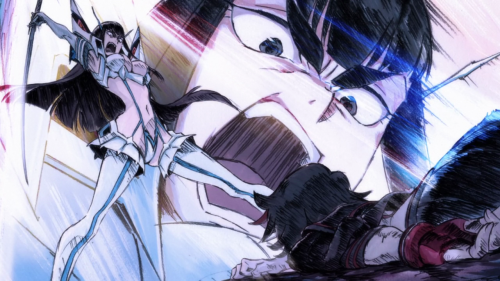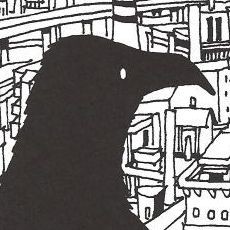Kill la Kill defies comparison. It’s from the writer and director duo that brought us the beloved Gurren Lagann and it reads a lot like the classic Revolutionary Girl Utena but come into Kill la Kill expecting a series like those two and you’ll be disappointed. It’s its own animal, albeit with a twist of parental DNA from Hiroyuki Imaishi, but even still, part of the fun is in starting each episode thinking I know what’s coming, only to have all of those expectations shoved back down my throat.
It’s quite funny really because this was such a hyped series. When people were making sarcastic remarks about Kill la Kill “saving anime,” others took that literally to mean that it was the second coming of Legend of the Galactic Heroes(/insert your favourite anime here.) You can imagine their disappointment when greeted by this crass, cartoonish mess of slapstick and fan-service. “All of that hype for this…? This… thing?! What is this?!”
Again, that’s all a part of the fun in watching Kill la Kill. It’s a cleansing agent for those of us who need reminding that our ideas of what anime is, or should be, amount to nothing in the face of such a raw creative force. In that sense, Hiroyuki Imaishi is a lot like Masaaki Yuasa, but where as Yuasa’s avant-garde aesthetics will always render him an outsider, Imaishi’s much more adept at pulling the wool over the typical anime fan’s eyes.
Neither director is afraid of the odd fart joke either, and I suppose it’s that utter silliness that still surprises me the most. Gurren Lagann was silly at first too, but after that certain spoilerific moment, everything changed. Rightly or wrongly, I’m expecting the same of Kill la Kill too, and deep down, I’m even hoping for it. Is there a story beyond this school? A villain beyond Satsuki? It’s for those reasons that each new episode feels like another pie in the face from Imaishi and writer Kazuki Nakashima. The more I scream, “take this story seriously, man!” the more I’m rebutted with a fourth wall breaking farce and animation that’s anti-realistic. In a strange way, I love that Kill la Kill attacks me for daring to take it seriously.
The use of fan-service is just another example of that anti-x attitude. Although Revolutionary Girl Utena is loaded with sexual undertone, it has an elegant, subtle aesthetic, and given the prominent billing of its female leads, many will have been expecting the same of Kill la Kill too, but here the girls are forced to fight scantily-clad in-front of crowds of ogling students. That’s the moment at which I’ll usually drop a series, but Kill la Kill makes a point of expressing both Ryuuko’s embarrassment of her naked body and Satsuki’s willingness to expose her’s in exchange for an awesome power.

“Exhibitionist? Nonsense! This is the form in which a Godrobe is able to unleash the most power! The fact that society’s values shame you only shows how small-time you are! If it means fulfilling my ambitions, I, Kiryuuin Satsuki, will show neither shame nor hesitation, even if I should bare my breasts for all the world to see! My actions are utterly pure!” –Kiryuuin Satsuki
By acknowledging it, by making it a part of the story and a choice on the behalf of the characters, it has fan-service that isn’t really fan-service at all, but you’ll need to square that notion with the part of your conscience that’s telling you that this is demeaning and perverted. Because it is, but it’s everything else as well.

Leave a Reply